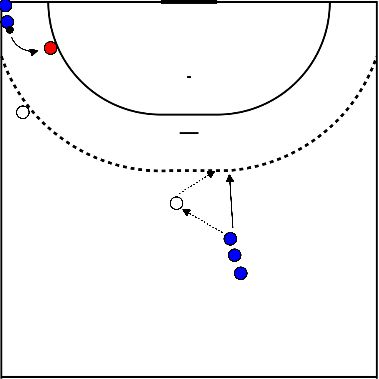Handball drills
- 2 pairs.
- One (defensive) player on the dotted line.
- Other (attacking) player in front of them.
- The offensive player tries to pass the defensive player between the pawns (without ball).
- One (defensive) player on the dotted line.
- Other (offensive) player in front.
- The attacking player tries to pass the defending player between the pawns (with ball).
- Possible shot on goal.
- Attackers:
- Quick movement.
- Continue shot attempt even though someone is hanging on to you.
- Defenders:
- Keep attacking player in front of you.
- Grasping at upper arms.
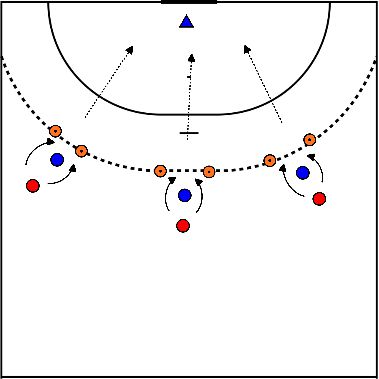
- 6 pawns in a row, one player at each pawn.
- Player at pawns 2-4-6 has a ball.
- 1 player with ball throws to player at pawn 1.
- Gets ball from player at pawn 2 walk on (watch the number of steps).
- Throws ball to player at pawn 3 etc.
- All players move up one pawn.
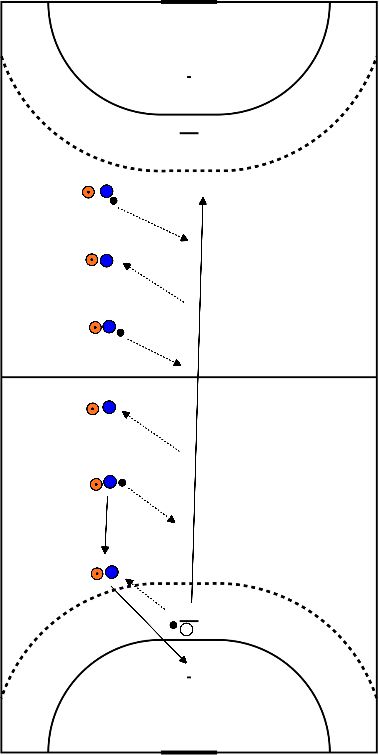
- 6 pawns in a row, one player at each pawn.
- Player at pawns 2-4-6 has a ball.
- 1 player with ball throws to player at pawn 1.
- Player with ball gets ball from player at pawn 2.
- throws ball to player at pawn 3 etc.
- All players move one pawn.
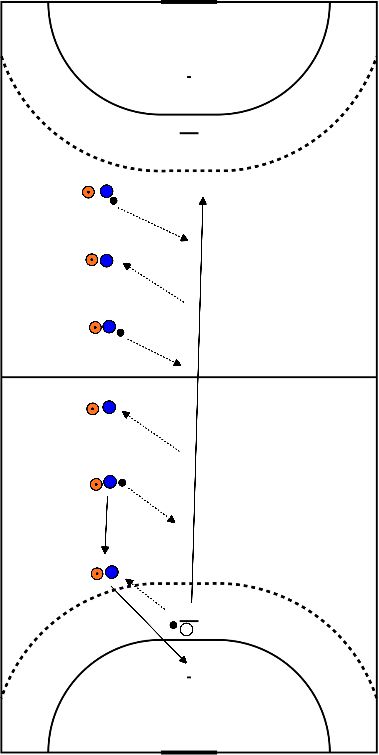
All players divide themselves into 2 rows behind the bench (bench is on the 9 meter line).
- The first 2 players stand on the bench.
- Jump off with 2 feet at the same time.
- Then make a passing move left of the post and pass on the right side of the post.
- Finish on goal. (Place pawns in the corners of the goal)
- All players line up with the ball near the centre line
- Everyone takes turns to throw at the goal
- Throwing from position, from the run and with a jump shot
- Pay attention to the way of throwing
- B1 plays on point.
- Runs through and receives the ball in the run and finishes with a running shot.
- R1 blocks the ball. (jumping and forearms against each other)
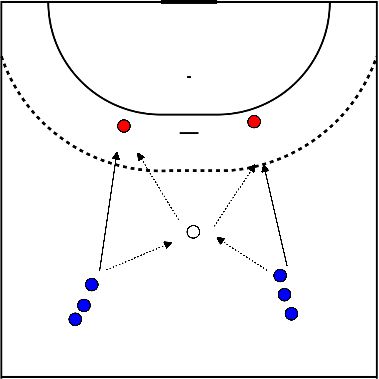
- This describes a system where the builders run a switch.
- The circle runner decides on which side the substitution will be made.
- If the circle runner is on the right side of the middle defender, the substitution is also made on the right.
- The middle constructor has the ball and gives a pass to the right constructor.
- The middle constructor, after playing the ball to the right constructor, puts a bar on the defending second constructor.
- The right hand builder goes behind the middle builder and ends up in the middle.
- The left-hand builder goes behind the right-hand builder again.
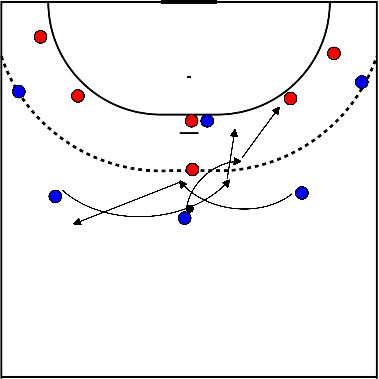
- This exchange takes place between circle runner.
- And the corner players.
- The circle runner moves without the ball from the middle to the side and puts a barrier on the defending corner player.
- The attacking corner player has the ball at that moment and can make use of the obstruction.
- Or pass the ball to the set-up player
- Who then passes the ball on to the half-career player and so on
- The attacking corner player who passed the ball on to the attacker "runs with the ball" inside the 9m, slowing down a little.
- He or she then comes between defender 2 and 3 towards the goal again and may receive the ball from the up-and-comer who has already received it at that point.
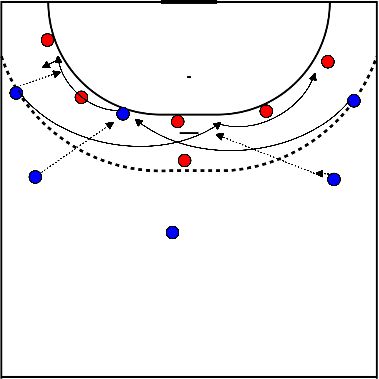
- You make pairs.
- Both persons stand on the circle at the same height as the poles.
- You run with 1 ball per pair to the other side of the circle.
- While running to the other side you throw the ball to each other.
- When you're on the other side you run back to the other side.
- Variation:
- Overhand throw.
- Knee-down passing.
- Passes with jump shot.
- Sideways jump to the opposite circle.
- Cross pass to the opposite circle.
- Accelerated pass. (50, 60, 70, 80 %)
- Sprint.
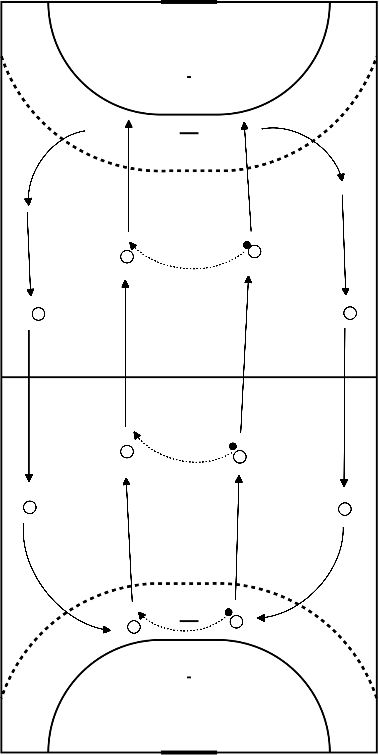
- First practise starting and throwing in the goalkeeper.
- Then cross.
- Player A plays to player B and runs around it.
- Gets the ball from player C.
- Player C runs around player B and gets the ball from him.
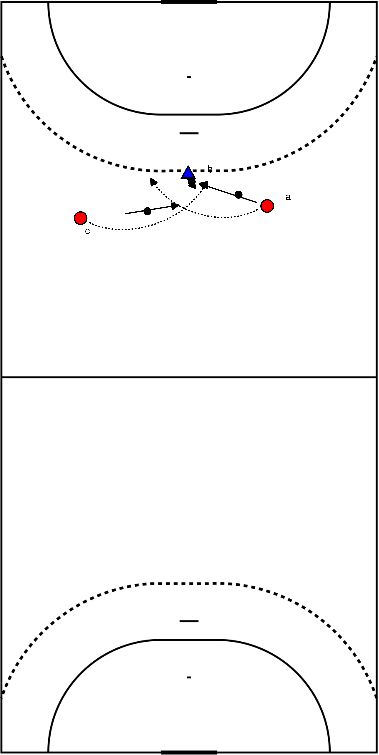
- You make 2 groups.
- 1 group has a vest.
- The groups must have an equal number.
- The children take turns standing in a circle. (So someone with a vest stands next to someone without vest).
- There are 2 balls and of each group 1 person has the ball (they face each other).
- You throw the ball as fast as possible to someone of your own group and try to catch the ball of the other group.
- If the ball falls, pick it up as quickly as possible and continue.
- Who will be first to catch the ball from the other team?
- If this goes well they all take 3 steps back and we increase the distance.
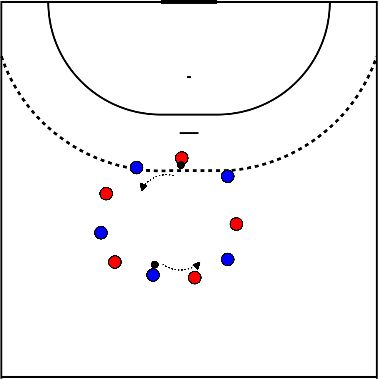
- Divide the groups into builders and corner players.
- The builders position themselves in the middle and the corner players on the left and right.
- Set-ups will practise the running shot
- There is 1 point of attack (alternates) who you play to.
- You receive the ball in the run and finish with a running shot
- It is important that you get the ball in the top corner and keep on running
- In this way, you can surprise the defence with your shot
- Do not take 3 big steps towards the run first, but keep to the rhythm of your run
- When you have fired your shot, walk through and bend your upper body slightly forwards.
- With this shot, it often happens that you stand with your wrong leg in front, this does not matter.
- The corner players will be working with various feints
- 1 feint for an outside pass and 1 feint between 1 and 2
- The ball is played to a corner player who feints an inward or an outward move (of your own choice, but alternate)
- There is a passive defender who, after a few times, starts to defend more and more
- It is important that you pressure the inside (or outside) and then quickly go around it
- You can also do this with a turn
